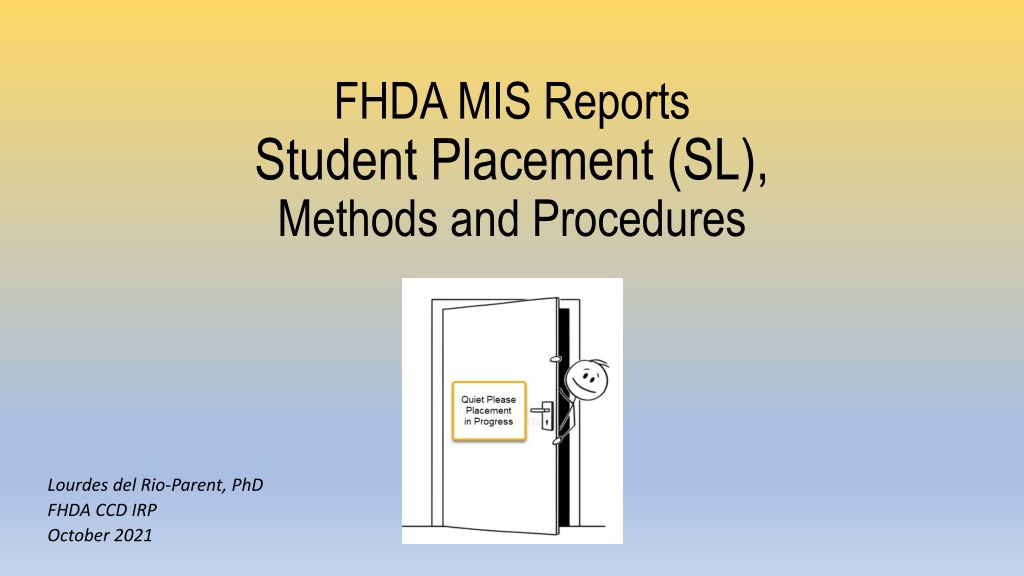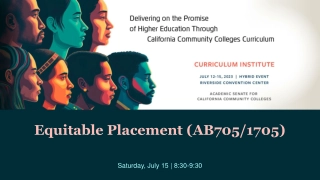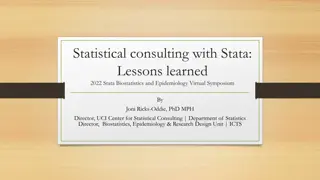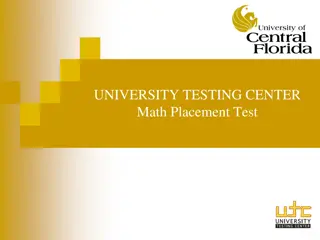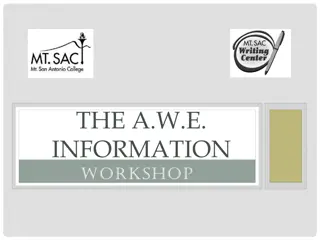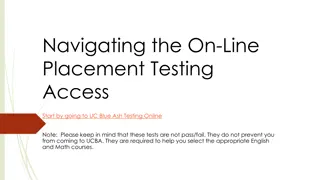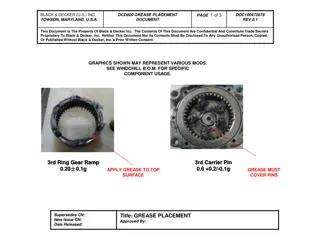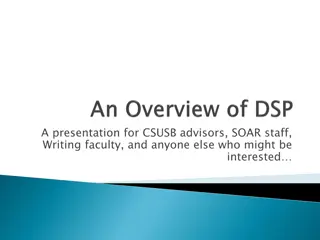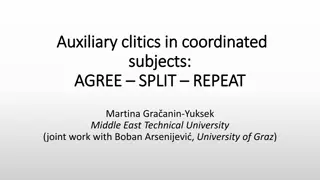Understanding Student Placement Models in Education
Explore the differences between Traditional and Pathway placement models in student education. Learn about the methods and procedures used to validate data for reporting, including the assessment of academic skill levels and course sequencing based on education goals and prior knowledge indicators. Delve into the intricacies of student placement in various math sequences and programs of study, with a focus on helping students find the right courses within a curriculum. Gain insights into the nuances of self-guided placement and the implications for reporting and data analysis.
Download Presentation

Please find below an Image/Link to download the presentation.
The content on the website is provided AS IS for your information and personal use only. It may not be sold, licensed, or shared on other websites without obtaining consent from the author. Download presentation by click this link. If you encounter any issues during the download, it is possible that the publisher has removed the file from their server.
E N D
Presentation Transcript
FHDA MIS Reports Student Placement (SL), Methods and Procedures Lourdes del Rio-Parent, PhD FHDA CCD IRP October 2021
Presentation Objectives Presentation Objectives At the end of this presentation, the audience will be able to describe: 1. Differences between the Traditional and Pathway placement models and their implications for reporting and analyzing data submitted in the MS SL (Student Placement) report. 2. Methods used to validate data for reporting, including the use of: Crosswalk tables (parent and child tables) SOATEST and MIS SL data values Placement course characteristics (credit status, transfer, pre-college level, TOP code) to identify SL02 Placement Type and SL06 Placement Level Procedures to reduce meaningless or unnecessary data
Placement: Traditional Model, Math Sequence Placement: Traditional Model, Math Sequence Calculus Precalculus Statistics Algebra Pre-College Level Assessment of students academic skill levels within a subject area or discipline to place them at the right course within a sequence. Emphasis was placed on the assessment of entry level skills using standardized tests.
Placement: Pathways Model Placement: Pathways Model Takes into account students o Education goal o Program of studies (major) o Prior knowledge Indicators (e.g., GPA, academic history) Provides opportunity for students input (self-guided placement)
Placement: Pathway Model, Math Placement: Pathway Model, Math Based on education goal, program of studies and indicators of prior knowledge (e.g., High School GPA, academic history), students are assigned to a course sequence: SLAM (Statistics and Liberal Arts Math) or B-STEM (Business, Science, Technology, Engineering and Math). The key difference between a SLAM and B-STEM course sequence is whether the program of study requires calculus. Yes No SLAM B-STEM Calculus required ?
Gen Math Course Sequence: SLAM to B Gen Math Course Sequence: SLAM to B- -STEM STEM SLAM B-STEM Open Registration Courses ControlledRegistration Courses
Placement: Traditional Placement: Traditional vs Pathways vs Pathways Traditional Model Placement in college level ESL, English, or math courses was dependent on the assessment of students skills & knowledge usually through standardized testing. Placement in pre-college level was determined when the student did not meet requirements (e.g., minimum test score) for college level coursework. First-time or first-time transfer students who planned on taking ESL, English, or math college level courses were expected to take at least one placement test or bring their transcript for evaluation. Pathways Model Provides access to the college level course sequence for ESL, English, or math (at least the first course in the sequence). Depending on HS GPA or academic history, support may be required. Placement data/records can be created automatically by the submission of a college admissions application, independently of whether the student intends to enroll in an ESL, English, or math course. Encourages self-guided placement
MIS SL (Student Placement) Domain MIS SL (Student Placement) Domain The purpose of MIS SL is to report data on students placement in English, mathematics, or ESL courses occurring during the reporting academic year.
MIS SL Data Elements MIS SL Data Elements SL01-PLACEMENT-DATE: Date the placement occurred SL02-PLACEMENT-TYPE: Type of placement A-English course placement B-Business, Science, Technology, Engineering or Mathematics (B-STEM) pathways mathematics course placement C-Statistics or Liberal Arts Mathematics (SLAM) pathways mathematics course placement D-English as a Second Language Writing course placement E-English as a Second Language Reading course placement F-English as a Second Language Speaking/Listening course placement G-English as a Second Language Grammar course placement H-English as a Second Language Listening course placement I-English as a Second Language Integrated course placement
MIS SL Data Elements (cont.) MIS SL Data Elements (cont.) SL03-PLACEMENT-SOURCE-HIGH-SCHOOL: Whether the placement was based on high school grades and/or GPA and the methodology used to make the placement. A-High school grades/GPA using the Statewide Default Placement Rules B-High school grades/GPA using local placement methodology N-Placement not based on high school grades/GPA
MIS SL Data Elements (cont.) MIS SL Data Elements (cont.) SL04-PLACEMENT-SOURCE-GUIDED-SELF: Whether the placement was based on guided and/or self-placement and the methodology used to make the placement. A-Guided placement: Locally developed tool or process, potentially in consultation with counselors or other faculty, used to place students into a course. B-Guided self-placement: Locally developed tool or process, potentially in consultation with counselors or other faculty, in which student is given a placement recommendation, but students are ultimately allowed to choose their placement. C-Self-placement: Process by which students may be provided information about courses and other self-assessment but no recommendation is made and student chooses their own placement. N-Placement not based on guided or self-placement
MIS SL Data Elements (cont.) MIS SL Data Elements (cont.) SL05 PLACEMENT-SOURCE-TEST: Whether the placement was based on a standardized assessment test. A-Standardized assessment test N-Placement not based on standardized assessment test
MIS SL Data Elements (cont.) MIS SL Data Elements (cont.) SL06-PLACEMENT-LEVEL: Level of placement relative to the gateway transfer-level course in the discipline. T-Transfer-level placement with no support recommended R-Transfer-level placement with support recommended S-Transfer-level placement with support required A-One level below transfer-level placement B-Two levels below transfer-level placement C-Three levels below transfer-level placement D-Four levels below transfer-level placement E-Five levels below transfer-level placement F-Six levels below transfer-level placement G-Seven levels below transfer-level placement H-Eight levels below transfer-level placement
MIS SL Development Main Steps MIS SL Development Main Steps 1. Meet with data custodians and area managers to discuss report specifications and related data sources. 2. Develop crosswalk tables to process placement data shown in Banner-SOATEST. 3. Research placement student records for the reporting academic year and both colleges to identify issues to take into account when SQL scripts to extract/process data for the report. 4. Develop and test SAS scripts to submit the report.
MIS SL Development Main Steps MIS SL Development Main Steps 1. Meet with data custodians and area managers to discuss report specifications and related data sources. 2. Develop crosswalk tables to process placement data shown in Banner-SOATEST. 3. Research placement student records for the reporting academic year and both colleges to identify issues to take into account when developing SQL scripts to extract/process data for the report. 4. Develop and test SAS scripts to submit the report.
Crosswalks Tables: MIS_SL_STVTESC Crosswalks Tables: MIS_SL_STVTESC MIS_SL_STVTESC is the parent table and includes the following: COLLEGE: De Anza or Foothill ACADEMIC_YEAR: Reporting academic year SUBJECT: English, ESL, Math, or Other STVTESC_CODE: Banner test code STVTESC_DESC: Banner test code description/label SL02_PLAC_TYPE: Identifies English placement codes only SL03_PLAC_SRC_HIGH_SCH: Crosswalk of STVTESC and MIS SL03 codes SL04_PLAC_SRC_GUI_SELF: Crosswalk of STVTESC and MIS SL04 codes SL05_PLAC_SRC_TEST: Crosswalk of STVTESC and MIS SL04 codes
Crosswalks Tables: MIS_SL_TESC_SCORE Crosswalks Tables: MIS_SL_TESC_SCORE MIS_SL_TESC_SCORE is the child table and includes the following: COLLEGE: De Anza or Foothill ACADEMIC_YEAR: Reporting academic year SUBJECT: English, ESL, Math, or Other STVTESC_CODE: Banner test code STVTESC_DESC: Banner test code description/label TEST_SCORE: Banner test score COURSE_SUBJ: Banner subject code for main course COURSE_NUMB: Banner number code for main course COURSE_TITLE: Banner title for main course SUPPORT_RECOMM: Identifies if the placement, based on test score, requires or recommends co-enrollment in support course.
Crosswalks Tables: MIS_SL_TESC_SCORE (cont.) Crosswalks Tables: MIS_SL_TESC_SCORE (cont.) CB21_CRSE_PRIOR_TO_COLL: CB21 for main course CB03_CRSE_TOP_CODE: CB03 for main course CB05_CRSE_TRANF_ST: CB05 for main course CB04_CREDIT_ST: CB04 for main course COURSE_MATH_STEM: Identifies math B-STEM course (pre-calculus or higher) SL02_TYPE_SCORE: SL02 from parent table for English; for Math, SL02 based on COURSE_MATH_STEM ; for ESL, SL02 based on course TOP code SL03_HIGH_SCH_SCORE: SL03 from parent table SL04_GUI_SELF_SCORE: SL03 from parent table SL05_TEST_SCORE: SL05 from parent table SL06_PLAC_LEV_SCORE: SL06 based on CB data and SUPPORT_RECOMM
MIS_SL_TESC_SCORE: SL02 & SL06 Coding MIS_SL_TESC_SCORE: SL02 & SL06 Coding Main purpose of MIS_SL_TESC_SCORE table is identify values for SL02, placement type, for math and English and SL06, placement level. SL02 for math: When the math test-score combination allows the student to register in pre-calculus with no required support, or above, then placement is classified as B-STEM. Test-score combinations that do not allow registration in a pre-calculus course without support are classified as SLAM. SL02 for ESL: Based on the TOP code for the course linked to the test-score combination (code for ESL integrated, writing, speaking, or listening) . SL06: Primarily based on the CB05 & CB21 for course linked to the test-score combination and whether support is required or recommended.
Rationale for the Use of Crosswalk Tables Rationale for the Use of Crosswalk Tables Facilitates establishing, reviewing, and updating relationships between data fields Cascade data across tables Information on the parent table (test code-MIS SL code) can be passed on to the child table. Expand information when linked to other tables Descriptors or labels from lookup tables can be added to facilitate review Export to documents (e.g., Excel, CSV) for review by data custodians Simplifies coding for updates Supports data cleanup for it can be used to identify test codes and test-scores combinations to be included or excluded from the final data set.
Rationale for the Use of Crosswalk Tables (cont.) Rationale for the Use of Crosswalk Tables (cont.)
Research Placement Data Research Placement Data SORTEST Key purpose: to store data used to control access to course registration. Processes for data entry/processing may differ across colleges May need to be processed significantly to be used for research or reporting Example: Math scores declining in consecutive dates Used by the college to control registration in math courses but undermines the validity of the data for research or reporting (i.e., difficult to understand or process)
Research Placement Data (cont.) Research Placement Data (cont.) Multiple placement records may be created in Banner-SOATEST to facilitate course registration; however, this practice may introduce noise and cause confusion during data analysis. For example, records in Banner-SOATEST may show students placed on statistics and precalculus on the very same date, even when one may expect only one record showing the highest level in the course sequence.
Research Placement Data: Example 1 Research Placement Data: Example 1
Research Placement Data: Example 2 Research Placement Data: Example 2
Questions Questions?
